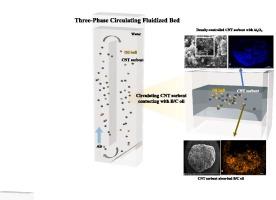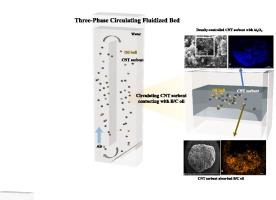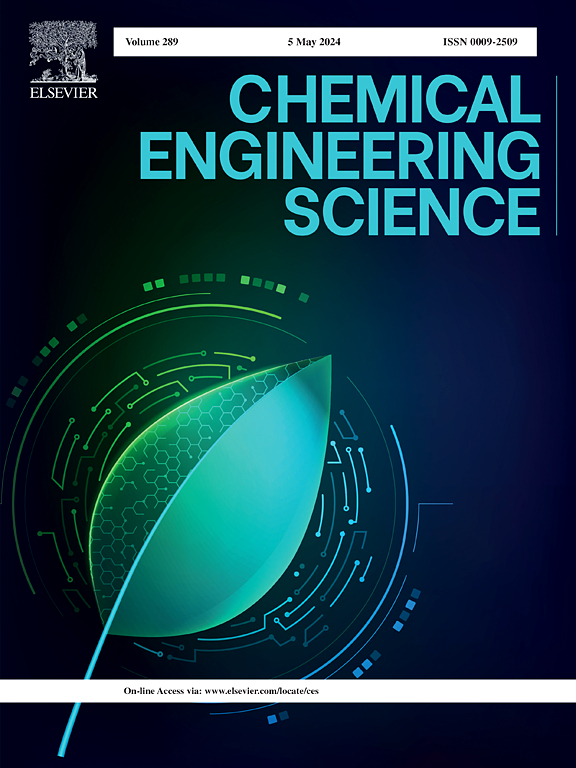Oily wastewater treatment using a CNT sorbent in a three-phase circulating fluidized bed
IF 4.1
2区 工程技术
Q2 ENGINEERING, CHEMICAL
引用次数: 0
Abstract
Fine emulsified heavy-oil droplets in wastewater can be easily dispersed in aquatic system, making it challenging to remove them using sorbents. Carbon nanotube (CNT) sorbents were prepared using a m-cresol solvent to remove emulsified heavy oil in wastewater. The bead-shaped and density-controlled sorbents (diameter: 5.22 mm; density: 1169 kg/m3) facilitated efficient contact with emulsified oil and were suitable for use in a three-phase circulating fluidized bed (TPCFB). The sorbents feature a sorption capacity of 2.4 g oil/g sorbent which remained consistent for at least 10 cycles. The hydrodynamic characteristics of the TPCFB reactor (120 × 80 mm; height: 800 mm) were determined and it was found that the circulation of both liquid and solid within the TPCFB was driven by the density difference between the riser and downcomer (Δρ). The solid holdups in the downcomer (εs,d) were almost constant with gas velocity and were proportional to the amount of sorbent inventory. The optimal region for emulsified oil removal was determined to be the downcomer, where turbulent flow was generated that facilitated close contact between the particles and the liquid. The solid circulation rate (Gs) increased to a constant value with Δρ, with the maximum Gs being proportional to the sorbent inventory. The optimal conditions for wastewater treatment were determined to be a maximum εs,d of 0.03 with a Gs value above 10.0 kg/m2s and a sorbent inventory of 90 g. The oil removal rate reached a maximum of 94.8 % at Gs = 12.2 kg/m2s. Used CNT sorbent exhibited unique oil sorption characteristics of CNTs, featuring an even distribution of sulfur on the surface and a weight loss arising from loss of oil at 350–500°C.


在三相循环流化床中使用碳纳米管吸附剂处理含油废水
废水中细小的乳化重油液滴很容易分散在水生系统中,因此使用吸油剂去除这些液滴具有挑战性。本研究利用间甲酚溶剂制备了碳纳米管(CNT)吸附剂来去除废水中的乳化重油。这种珠状、密度可控的吸附剂(直径:5.22 毫米;密度:1169 千克/立方米)有助于与乳化油有效接触,适合在三相循环流化床(TPCFB)中使用。这种吸附剂的吸附能力为 2.4 克油/克吸附剂,至少在 10 个循环中保持不变。对 TPCFB 反应器(120 × 80 毫米;高:800 毫米)的流体动力学特性进行了测定,发现 TPCFB 内液体和固体的循环是由上升管和下降管之间的密度差(Δρ)驱动的。导流筒中的固体滞留量(εs,d)几乎与气体速度保持恒定,并与吸附剂库存量成正比。乳化油去除的最佳区域被确定为导流筒,在这里产生的湍流有利于颗粒与液体的紧密接触。固体循环速率(Gs)随 Δρ 的增加而增加到一个恒定值,最大 Gs 与吸附剂存量成正比。废水处理的最佳条件被确定为最大 εs,d 为 0.03,Gs 值高于 10.0 kg/m2s,吸油剂存量为 90 g。当 Gs = 12.2 kg/m2s 时,油的去除率达到最大值 94.8%。使用过的 CNT 吸附剂表现出 CNT 独特的吸油特性,其特点是硫在表面均匀分布,并且在 350-500°C 温度下油会失重。
本文章由计算机程序翻译,如有差异,请以英文原文为准。
求助全文
约1分钟内获得全文
求助全文
来源期刊

Chemical Engineering Science
工程技术-工程:化工
CiteScore
7.50
自引率
8.50%
发文量
1025
审稿时长
50 days
期刊介绍:
Chemical engineering enables the transformation of natural resources and energy into useful products for society. It draws on and applies natural sciences, mathematics and economics, and has developed fundamental engineering science that underpins the discipline.
Chemical Engineering Science (CES) has been publishing papers on the fundamentals of chemical engineering since 1951. CES is the platform where the most significant advances in the discipline have ever since been published. Chemical Engineering Science has accompanied and sustained chemical engineering through its development into the vibrant and broad scientific discipline it is today.
 求助内容:
求助内容: 应助结果提醒方式:
应助结果提醒方式:


